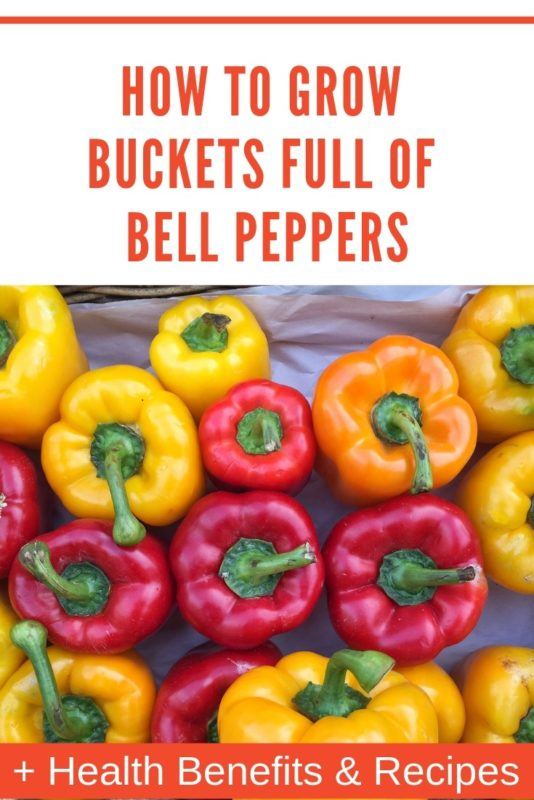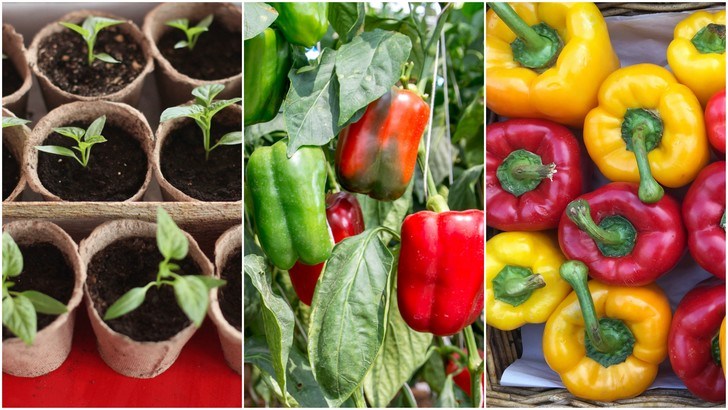
There is nothing more beautiful than a basket full of homegrown bell peppers. I have been growing bell peppers in my garden for the last twenty years and have never been disappointed.
There are many reasons to love bell peppers besides their beauty. For starters, they are really easy to grow, they are loaded with nutritional value and they taste amazing raw and cooked. If you are a first-time gardener, peppers are a great place to start.
Bell peppers, also known as sweet peppers can be red, yellow, orange, green or even lavender and white. Bell peppers are the only members of the genus Capisicum that does not produce capsaicin, the extremely hot chemical that we are familiar with in hot peppers.
Peppers are native to Mexico, Central America, and northern South America.
To grow this tender tropical warm-season plant you can either start seeds early indoors or purchase plants after the risk of frost has passed.
Only those that live in very warm climates such as the deep south can start seeds outdoors.
Starting Seeds Indoors
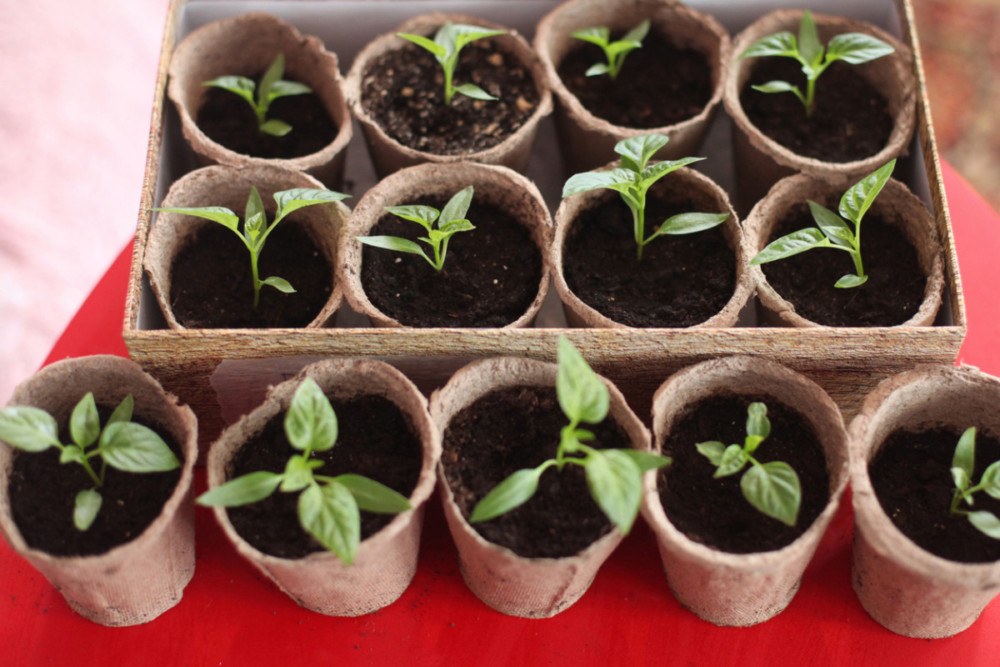
Starting seeds indoors will save you money and give you a headstart on the growing season. This is particularly useful if you live in an area with a short growing season. Seeds should be started about 8-10 weeks before the last spring frost date.
- Choose high-quality organic seeds for best results.
- Fill small starter pots with organic potting soil. I like the little biodegradable pots that can be planted directly into the ground.
- Place three seeds in each pot and cover with a light layer of soil.
- Place in a warm area with plenty of light – pepper seeds will germinate at 70 degrees and warmer.
- Keep the soil moist but not saturated.
- Once the seedlings begin to grow, thin out the weakest one and let the other two grow.
- Fourteen days before transplanting, begin to harden off your plants. To do this water the plants first and place them outdoors in a sheltered spot. If you have a cold frame or unheated greenhouse this works great. Be sure to harden off on days when the temperature is steady. Leave your plants outside for two hours on the first day, four hours on the second day with more direct sun. Gradually increase the amount of time the plants spend outdoors in direct sunlight. Do this over two weeks time. You can leave the plants outside all night only if there is no danger of frost.
- Add organic fertilizer or aged compost to your garden soil one week before transplanting pepper plants.
- Transplant the seedlings outdoors after all threat of frost has passed. The soil must be at least 65 degrees or the plants will not make it. If you need to warm up your soil, put a layer of black plastic over it for about two weeks before planting. Place plants 18 to 24 inches apart but keep the plants that shared a pot close so they will touch.
- Place three matchsticks in the hole with each plant and add one teaspoon of organic fertilizer. This will give the plants sulfur which helps them grow.
- Once peppers get their true leaves, fertilize weekly until fruit appears.
- Water peppers regularly but do not saturate.
Starting Pepper Plants

If you start with more mature pepper plants, place them 18 inches apart in garden soil that is rich with organic matter.
Peppers also grow well in raised beds and containers. Add slow-release organic fertilizer to the hole when planting. To grow large, healthy peppers, plants need between 6 and 8 hours of sunlight daily.
Water plants immediately and provide 1 to 2 inches of water per week – more if the weather is hotter. Feed plants every three weeks after fruit sets with an organic fertilizer to promote growth.
Apply mulch or straw around each plant to help retain moisture. Provide support to pepper plants as they grow.
Harvesting
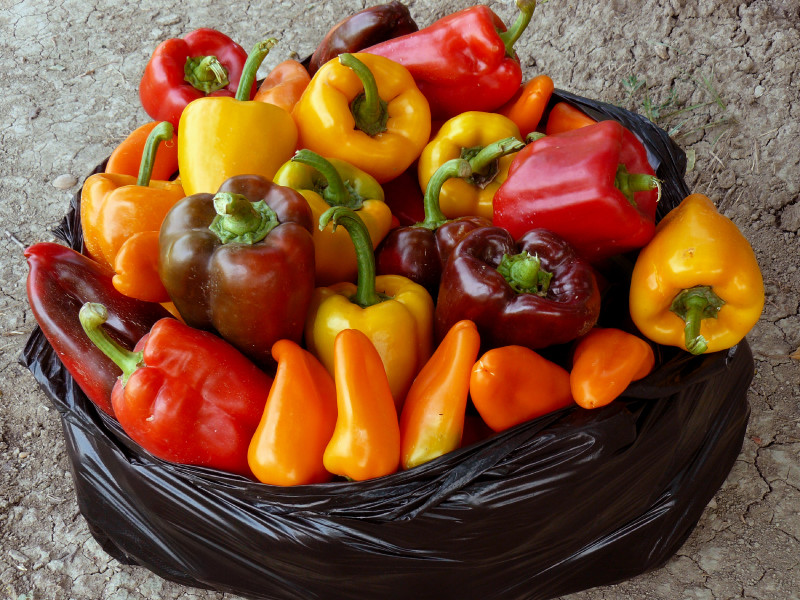
- Harvest peppers as soon as they reach a good size.
- As peppers stay on the vine they become sweeter and also contain more vitamin C.
- Don’t pull peppers off of the vine, instead use sharp and clean scissors or a sharp and clean knife to remove fruit from the plant.
Storing Peppers
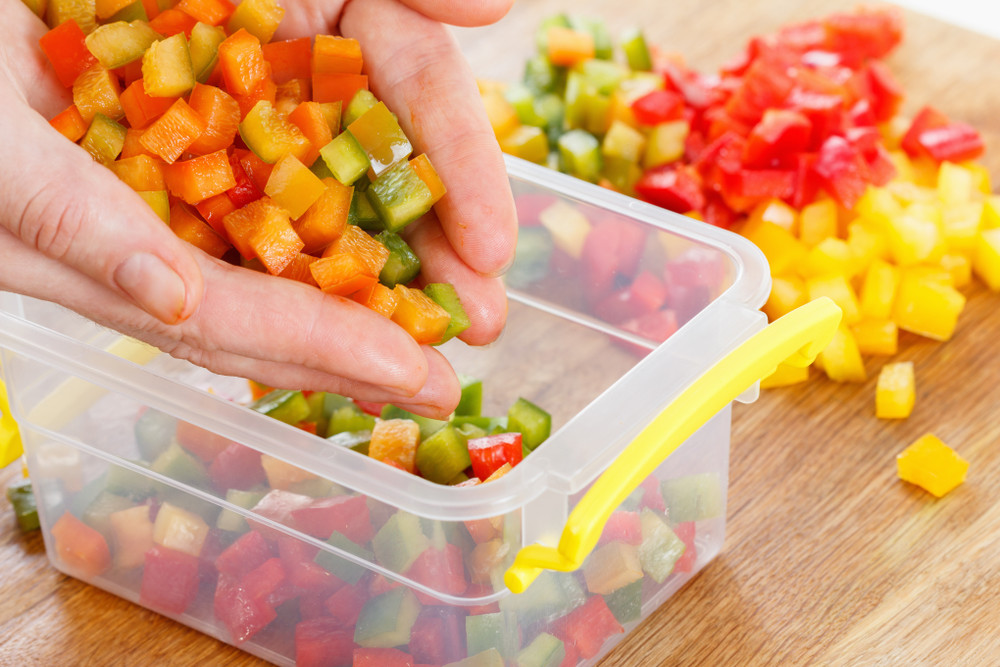
Place peppers in a plastic bag and refrigerate for up to ten days after harvesting.
You can also dry peppers in a conventional oven. First, wash peppers and remove all seeds. Cut them into one-half-inch strips. Steam the strips for ten minutes and spread on a baking sheet. Set the oven to 140 degrees and dry peppers until they are brittle. Once peppers are cool, place them in storage bags.
Freezing peppers is also a great way to store your harvest. I like to freeze them and use in soups and stews all winter. Wash peppers first and cut off stems. Cut peppers in half and remove seeds and membranes. Cut into strips or even dice and place on a cookie sheet. Put the cookie sheet in the freezer for about an hour or until frozen. Place the frozen peppers in a freezer bag, removing as much air as possible.
9 Tips For Bigger & Tastier Peppers
- Always choose high-quality pepper seeds and plants.
- Never plant seedlings in cool and moist soil. Peppers like the heat.
- Fertilize with compost tea or fish emulsion for robust plants.
- Use a drip irrigation system for a regular supply of water.
- Pinch off some of the early flowers.
- Pinch off all suckers.
- Weed around pepper plants regularly.
- For larger fruit, spray the plants with a mixture of one tablespoon Epsom salts in one gallon of water once when the plants bloom and once every ten days after.
- To keep new seedlings warm, place a cage around them and wrap plastic around the cage. This creates a mini greenhouse.
Health Benefits Of Bell Peppers
Although we often think of peppers as vegetables, they are actually a fruit. The nutritional value of peppers depends on which color you choose. A red bell pepper, for example, contains over eight times the amount of vitamin A than a green bell pepper.
All bell peppers contain a large number of antioxidants. One pepper contains twice the daily recommended amount of vitamin C and plenty of vitamin B6.
Other vitamins and nutrients in bell peppers include:
- Vitamin B1
- Vitamin B2
- Vitamin B3
- Vitamin E
- Vitamin K
- Manganese
- Magnesium
- Phosphorus
- Potassium
- Molybdenum
- Fiber
Carotenoids: Red bell peppers get their beautiful hue from a special antioxidant known as lycopene. This carotenoid helps fight free radicals from toxins. Research has shown that lycopene can help prevent certain types of cancer including prostate, lung, and stomach. Carotenoids found in yellow and orange peppers help protect against cardiovascular disease.
Fact: A 2008 study found that steaming bell peppers improved their “bile acid binding capacity.” This results in fewer recirculated bile acids, better use of cholesterol and lower absorption of fat which reduces the risk of heart disease.
Peppers are a great source of potassium: All bell peppers are a great source of potassium. Potassium is an essential balancing mineral that helps regulate blood pressure and muscle function.
Bell peppers also contain fiber which helps regulate cholesterol and aids in digestion as well as folate which is essential for red blood cell functioning.
Bell Pepper Recipes
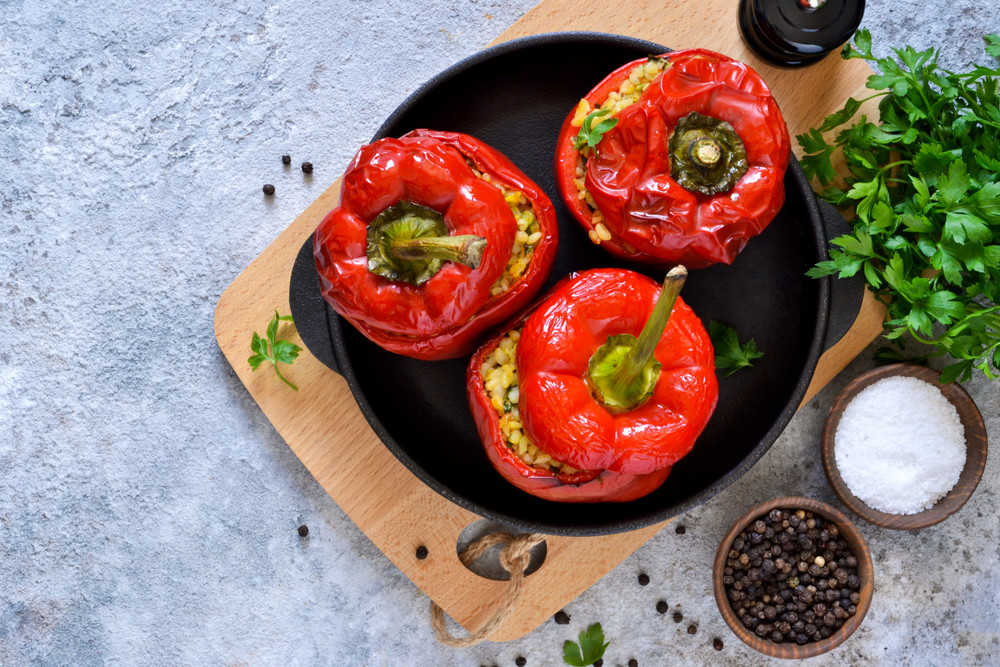
Bell peppers are great on their own for a nutritious snack but also go well in many delicious dishes. Here are three easy ways to benefit from the goodness of homegrown bell peppers.
Stuffed Bison Peppers
If you are looking for a healthy meal for guests, this one is it. It tastes as good as it looks and is loaded with nutrition and health-promoting ingredients.
Ingredients:
- 4 medium bell peppers halved
- 2 teaspoons coconut oil
- 1 cup onion chopped
- 8 ounces ground bison
- 1 clove garlic
- 2 teaspoon cumin
- 2 teaspoon chili powder
- 1 cup black beans
- 1 cup salsa
- 1 cup brown rice cooked
- 1/2 cup shredded parmesan cheese
- Chopped scallions & fresh cilantro
Method:
- Coat a 9×13 baking pan with coconut oil.
- Place the peppers, cut side up, in the dish.
- Heat coconut oil on the stove and cook onion until soft.
- Add the bison and spices.
- Add beans, salsa, and rice.
- Fill each pepper with the mixture.
- Cover the dish with aluminum foil and bake for 30 minutes.
- Uncover, top with cheese and bake until cheese melts.
- Top with scallions and cilantro.
Bell Pepper & Avocado Medley
This salad is great paired with organic roast chicken or even on its own for a light lunch or snack.
Ingredients:
- 1 ripe avocado, diced
- 1 large bell pepper, diced
- ½ cup cherry tomatoes, halved
- 2 green onions, sliced
- 2 tablespoons fresh minced parsley or cilantro
- Juice of one lemon
- Salt and pepper
Method:
Mix all ingredients together in a bowl and enjoy.
Sweet Pepper Breakfast Smoothie
I love to drink this in the morning for a burst of energy.
Ingredients:
- 1 medium banana, peeled fresh or frozen
- 1 can(8 ounces) pineapple, drained
- 1?2 cup red bell pepper, seeded and chopped
- 2 cups frozen mixed berries
- 1 cup filtered water
Method:
Add all ingredients to a blender and mix well. Serve immediately.
Pin This To Save For Later
